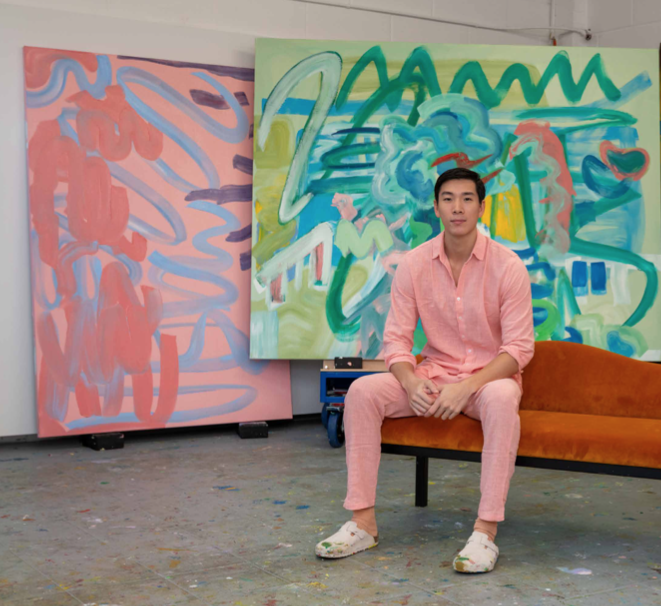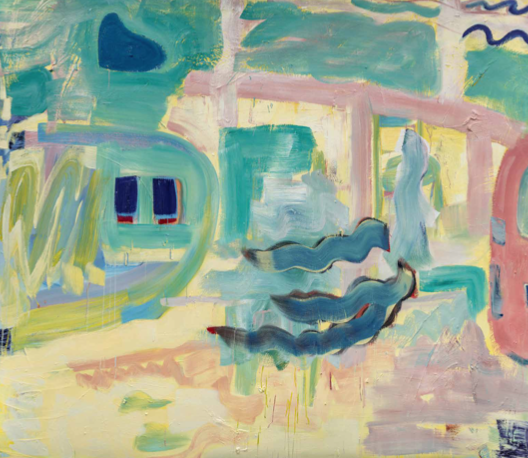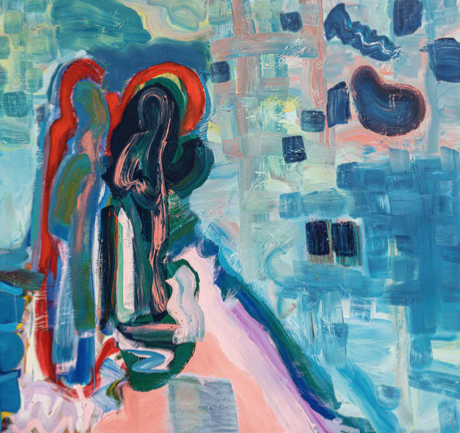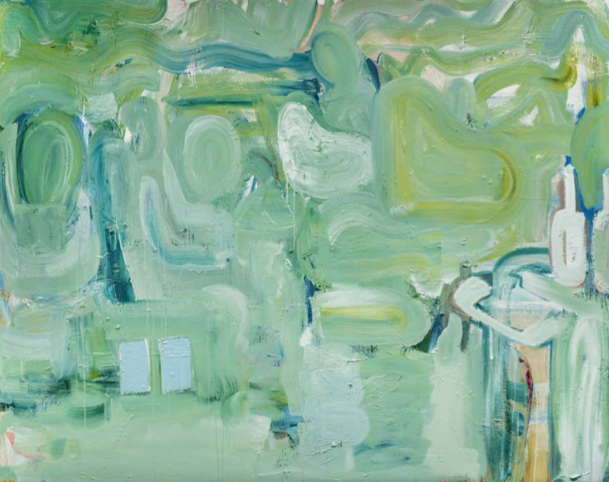Born in 1993, narrative painter Channatip Chanvipava transfigures stories of his past into cascades of colour and image, pulling mental imagery captured both involuntarily and voluntarily as reference. He talks to Stephenie Gee

Tell us about the trajectory of your artist career.
I see myself as always having been an artist. I’ve always had the need to create and paint, and I’ve been creating since I was very young. I even asked my parents for painting lessons from probably age eight and I was recreating oil paintings by Impressionists using acrylic, Monet in particular. I continued art until the end of high school, and I graduated from the London School of Economics – this is because I wasn’t allowed to pursue fine arts at university for my undergrad. I went down this other route where I didn’t create or paint for five years. Then I picked up the brush again when I left my first job and I’ve been painting ever since. When I did start painting again, I really wasn’t ready to let go of my work and I wasn’t earning any money from art because I wasn’t selling. I had my first studio in Hong Kong at Hart Haus in Kennedy Town and it was when I got my second studio in London when I stopped everything and just focused on painting. This led to my first show a year later, and five more followed. I paint because I just feel let down by words. I’ve always had difficulty in expressing myself through words, and so the paint carries me.
What inspires you?
I’m a narrative painter. I create autobiographical work and I use observations, stories and memories in my process to create my paintings. And within these observations, stories and memories, I pull mental imagery as references. So it’s very much using the process of recollection and the subjectivity of memory. I would combine all these references to create one collage of abstraction and then I transfer this onto the canvas.
Can you tell us about your process? I know you don’t sketch beforehand.
Yes, I paint directly onto the canvas. I don’t sketch before, I don’t experiment and I don’t test colour. I do this because I feel like it’s the most honest way of transferring the mental imagery directly onto the canvas, and I allow the motion, the action, the emotion and the intuition to sort of guide and transfer this mental imagery.

Can you tell us about your style? Colour seems to play a big part and it’s quite abstract but we also see hints of forms and figures.
I use oils and I’m consistent with my brush, using one size. I allow motion and impulse to transfer my mental collage abstraction directly onto the canvas. There is dynamism and action on my canvas. I think the physical and emotional intuition is what defines my painting style. Colour is very important for me because I give colour a value which is invisible and internal, and when I transfer it onto the canvas, that value sort of intensifies. For example, emotion can feel yellow, and when you paint it on, it looks yellow. So colour helps me in terms of pushing the meaning and feeling of what I’m trying to express. It sort of amplifies the storytelling.
Why oil paint?
I love oil paint just because the hues and the colours are a lot deeper compared to acrylic. It also has this sculptural quality that I can create these textures out of. The depth of the colour is just deeper and because it takes so long to dry, you have more time to spend with the paint, and it just allows for more moments of reflection and contemplation.
You have some very large paintings and some very small paintings.
I like to paint large-scale paintings just because it gives me more range of motion, and I find that very satisfying. I’m very dynamic in how I paint. When I’m done working on a large-scale painting, I feel like I need small-scale painting, just because of the balance. And the smaller paintings are a lot more intimate and the emotions are a lot slower. You spend more time with a smaller painting actually, because you have to wait for the paint to dry and the layers are thicker. It’s a very patient process.

How do you want your viewers to respond to your work?
I like the viewer to respond and relate to the painting in their own way. I think as a viewer it’s important to connect to the painting, to connect briefly and then the emotion comes. If I’m prompted, then I would obviously share the story behind the paintings but I just want the viewer to connect.
Tell us more about your upcoming exhibition, The Sound of Many Waters, in Venice?
The Sound of Many Waters is a solo presentation that’s been organised and curated by Roman Road, the gallery that I’ve been working with from the very beginning, and this show coincides with the Venice Biennale this year. The Sound of Many Waters is eight works of mine and it’s about identities, belonging and the subjectivity of memory, and it really addresses the concepts of time linear, queer identity and connection in a divided world. All the paintings are based on queer sensibilities and have their own stories and universes.
Also see: French May Arts Festival, French GourMay Food and Wine Festival starts March 16 – see programme
Talking about identity, has your multicultural upbringing influenced your work in any way?
Yes, of course. Being ethnically Chinese, born in Thailand, raised by a Malaysian mother and growing up in the West is definitely part of my identity and it definitely influences my work. Especially when it comes to paintings that really speak to filial piety or family intimacy and queer sensitivities that are very much interlinked to my multicultural upbringing and identity. It’s just how I see and view the world, and it’s how I’ve experienced the world through that background and upbringing and environment.
What has been the most memorable artwork you’ve created and why?
The most memorable artwork that I’ve created was this first painting I did five years ago when I picked up the brush again, and it’s titled Lost and Found. I stopped creating for such a long time that it felt like such a relief where I was just holding so much in for so long. That painting took me four months to complete, and I kept it. It still lives with me. It’s very much about overcoming the fear and the change and working through those emotions. And the process behind that painting has stuck with me until now and has been consistent ever since. And when I did that painting with my symbols and figures which appeared then, they have also stuck with me ever since. They keep me grounded and they keep me honest.
What are these symbols?
So the symbols, which are recurring in all my paintings, are the parallel lines and they represent the heart centre which refers to a form of meditation that I practise. With each layer painted on the painting, every single time before I leave the studio, I need to have this symbol to ground the painting and, in a way, ground myself. The second symbol, I don’t know how to describe it but many people have referred to it as a heart shape that’s slightly rotated with a right angle. This to me is a form or entity that captures different things and it could be the link, the cloud, the window or even the energy of an aura of a person. It’s always transforming and changing. Each painting for me is also changing, and it’s a way to invite the viewer in and sort of relate to the painting.

What are some of the difficulties or challenges that you encounter when you’re creating your work?
When I paint, I work on each painting individually so I have to finish one before I can start another. The difficulty is sometimes I find myself fighting with the paint, and painting doesn’t come so easily. There’s a lot of memory work involved in my process, which is very emotional at the same time. Sometimes it’s a struggle, just an inability to paint and fighting with those emotions.
How do you overcome it?
The best thing for me to do when I get these thoughts is sort of step away and allow the paint to breathe and allow myself to breathe. Stepping away means leaving the studio and allowing the paint to dry, since I work with oils, and coming back to it with fresh eyes and new energy. And when you step away, you don’t take your focus off the painting. I go back to the process and meditate on it.
Do you have any artists that you look up to? Any visual influences?
The visual influences would be the Impressionists from when I was very young, and that would be Claude Monet in particular. But now it’s not the visual influences, because the visual influences come from my own practice. It’s very much internal. But I am influenced by other artists’ processes. Like Tracey Emin, she’s an autobiographical painter and she’s just relentlessly honest in how she paints. Another painter would be Georg Baselitz. I like how he’s able to paint about guilt in a way that transforms something negative into something beautiful.
What has been the most rewarding part of being an artist?
Art is connection for me. Connection to the self, to others, to nature, the past, the present, the future and even the spirit. The most rewarding part about being an artist is just being able to create and put my art into the world and share it. That’s the most rewarding part.























































